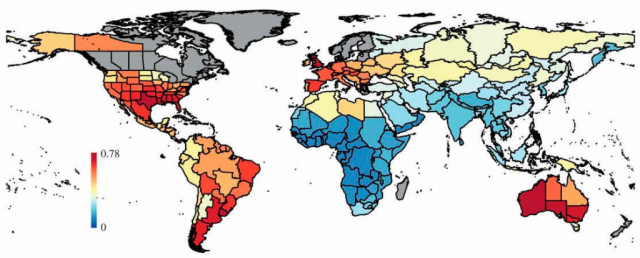| |
[Feb. 10th, 2019|10:46 am] |
#^https://doi.org/10.1098/rspb.2013.3254
Global late Quaternary megafauna extinctions linked to humans, not climate change
The late Quaternary megafauna extinction was a severe global-scale event. Two factors, climate change and modern humans, have received broad support as the primary drivers, but their absolute and relative importance remains controversial. To date, focus has been on the extinction chronology of individual or small groups of species, specific geographical regions or macroscale studies at very coarse geographical and taxonomic resolution, limiting the possibility of adequately testing the proposed hypotheses. We present, to our knowledge, the first global analysis of this extinction based on comprehensive country-level data on the geographical distribution of all large mammal species (more than or equal to 10 kg) that have gone globally or continentally extinct between the beginning of the Last Interglacial at 132 000 years BP and the late Holocene 1000 years BP, testing the relative roles played by glacial–interglacial climate change and humans. We show that the severity of extinction is strongly tied to hominin palaeobiogeography, with at most a weak, Eurasia-specific link to climate change. This first species-level macroscale analysis at relatively high geographical resolution provides strong support for modern humans as the primary driver of the worldwide megafauna losses during the late Quaternary.

The proportion of extinct large mammal species (more than or equal to 10 kg) in each TDWG country during the last 132 000 years, only counting extinctions earlier than 1000 years BP
Доля видов крупных (с массой тела 10 или более кг) млекопитающих, вымерших в период между 132 тыс. и 1 тыс. лет назад, в разных регионах
Главной причиной позднечетвертичного вымирания все-таки были люди, а не климат
В конце четвертичного периода по всем континентам прокатилась волна массового вымирания крупных животных. Специалисты уже много десятилетий спорят о том, что было главной причиной этого вымирания — климатические изменения или деятельность первобытных охотников. Комплексный анализ всех имеющихся палеоклиматических, палеонтологических и палеоантропологических данных, проведенный датскими учеными, показал, что антропогенный фактор был намного важнее климатического. Уровень вымирания крупных млекопитающих в разных регионах почти не коррелирует с амплитудой климатических изменений (слабая корреляция прослеживается лишь в Евразии), но очень сильно коррелирует со временем заселения региона людьми. В наименьшей степени вымирание затронуло Африку — историческую прародину рода Homo; сильнее всех пострадали регионы, лишь недавно заселенные представителями Homo sapiens.
#extirpation #hominid #humanism #past #revision #science #time #timespace #traumaticexp |
|
|